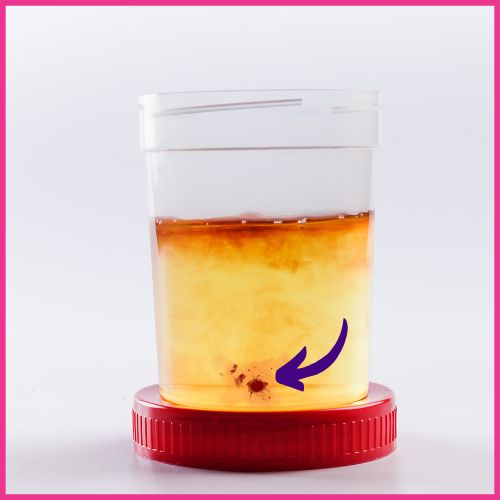Blood & Pus in Urine: Key Facts.
- Blood and pus in urine can appear as normal-looking yellow and clear urine or reddish urine with whitish speckles or debris, brownish turbid urine, or cloudy urine with small or large blood clots.
- The most common cause of blood and pus in urine is severe urinary tract infections.
- Other possible causes include kidney or urinary tract stones, indwelling urinary catheters, sexually transmitted infections, and recent trauma, instrumentation, or kidney or urinary tract operation.
- Treatment depends on the cause and may include antibiotics, stone removal, surgical removal of stones, or indwelling catheter replacement.
[1] What do Blood and pus in urine look like?
Combined blood and pus in urine typically look like this:
- Normal-looking yellow and clear urine (pus and blood cells appear only in urine analysis), or
- Reddish urine with whitish speckles or debris, or
- Brownish turbid urine, or
- Turbid or cloudy urine with small or large blood clots.
The image below shows one of the possible looks of combined pus and blood in the urine (dirty brown Urine).

Blood in urine typically looks like either:
- Pink to reddish urine (the darker red the urine color, the more profound is hematuria), or
- Blood clots in urine, or
- Brownish urine.
Pus in urine typically looks like either:
- Mild whitish or greyish speckles in urine (cloudy urine), or
- Complete opacity of urine (turbid, opaque, and greyish-looking urine), or
- Yellowish or greyish debris in urine, or
- Mild cases of pyuria maybe not be apparent to the human eye (only appear as pus cells under the microscope).
[2] Common Causes of Blood and Pus and urine.
[A] UTI (urinary tract infection).
The most common cause of blood and pus is severe urinary tract infections. Infections typically cause pus in urine and may cause blood in urine due to severe inflammation of the urinary tract lining.
UTI is the most common cause of combined pus cells and red blood cells in a urine analysis.
Suspect UTI if you notice blood and pus in urine along with symptoms such as:
- Burning during urination
- Frequent urination
- Urgency to urinate
- Bladder pain (lower abdominal pain).
Risk factors of UTI include:
- Being a woman (women are 30 times more likely to get UTI than men).
- Being older in age.
- Diabetes mellitus
- Chronic catheterization
- Recent sexual intercourse
- Prior history of urinary tract surgery
- Pregnancy
- Urine incontinence.
- Poor hygiene.
- Previous attacks of UTI.
Symptoms of UTI can be simple, confined to the urinary bladder, or complicated, extending beyond the bladder.
Symptoms of complicated UTI include all the classic symptoms of acute cystitis plus:
- Fever,
- Chills or rigors,
- Significant fatigue,
- Muscle aches or any other feature of systemic illness,
- Flank pain,
- Felvic or perineal pain in men and tenderness over the kidney area when your doctor examines it.
The presence of blood and pus in the urine usually indicates a severe form of UTI. Contact your doctor, as the condition usually needs more thorough investigations and urgent treatment.
Diagnosis:
Urinary tract infection is typically diagnosed by the presence of pyuria in urine cells, plus a positive culture test for bacteria and/or positive leucocyte esterase test in urine analysis.
Typically, blood and pus caused by UTI improve with proper antibiotic treatment and good hydration.
[B] Kidney or Urinary tract Stones.
The presence of urinary tract stones in the kidney, ureter, or urinary bladder may become complicated by either:
- Urinary tract obstruction (Hydronephrosis).
- Infection (Cystitis or pyelonephritis).
- Injury to the urinary tract lining when the stone moves through the urinary tract.
Patients with complicated urinary tract stones may experience pyuria (pus in urine) and hematuria (blood or blood clots in urine).
Symptoms:
- Severe, sharp pain in the side and back, below the ribs
- Pain that radiates to the lower abdomen and groin
- Pain that comes in waves and fluctuates in intensity
- Pain during urination
- Pink, red, or brown urine (combined blood and pus in urine)
- Cloudy or foul-smelling urine
- Nausea and vomiting
- Persistent urge to urinate
- Urinating more often than usual
- Fever and chills if an infection is present
Diagnosis:
Urinary tract stones can be diagnosed through various methods, including:
- Imaging tests (the main diagnostic method), such as X-rays, CT scans, and ultrasounds
- Blood tests to evaluate kidney function and detect signs of infection or inflammation.
- Urine tests to check for blood, pus, and other abnormal substances in the urine.
Precise diagnosis of the cause of blood and pus in the urine requires a thorough evaluation by a medical professional.
[C] Indwelling urinary catheters.
Current or recent use of indwelling urinary catheters is a predisposing factor for urinary tract infections. In fact, catheter-associated urinary tract infection is one of the most common healthcare-associated infections (reference).
Severe infections are common in people with debilitating or neurological diseases that use catheters for long periods. Infections may be severe, leading to blood and pus in the urine.
[D] STIs (Sexually transmitted infections).
Sexually-transmitted infections, particularly Gonorrhea and chlamydia infections, are also common causes of blood and pus in the urine.
In such an infection, pus and or bloody urine may come spontaneously from the urethral opening without urination (urethral discharge).
Common Symptoms:
- Pain or burning during urination
- Frequent urination
- Strong and persistent urge to urinate
- Blood or pus in the urine
- Lower abdominal pain or discomfort
- Pain during sexual intercourse
- Vaginal or urethral discharge (in women)
- Testicular pain (in men).
- Genital ulcers.
If you suspect a sexually transmitted urinary tract infection, seek medical attention and get tested as soon as possible.
[E] Recent trauma, instrumentation, or operation of the kidney or urinary tract.
Recent trauma, procedures, or catheter insertion are common causes of bloody urine and may also cause UTI.
Recalling any recent trauma or instrumentation of the urinary tract in the past few days before the appearance of blood and pus in urine is important.
Report any of the below incidents to your doctor or health care provider:
- Recent insertion of a urinary catheter.
- Trauma to the urethra during sexual activities or intercourse.
- Recent cystoscopy (a tool to visualize the bladder introduced through the urethra.
- Recent insertion of a ureteric stent (double-J stents).
- Recent operations (bladder, kidney, urethral, or prostatic).
- Taking a biopsy from the urinary bladder, kidney, or prostate.
- Blunt trauma to the perineum.
[3] Full list of causes of hematuria and pyuria.
In the previous section, we discussed the most common and likely causes of pus and blood in the urine.
Less common causes of blood and pus in urine are listed here. A combination of the causes may coexist, leading to pus and blood in the urine or in urine analysis.
[A] Causes of hematuria (blood in urine).
The table below illustrates the most possible causes of hematuria (common and rare) (reference).
| KIDNEY CAUSES |
|---|
| 1. benign or malignant kidney tumors. |
| 2. Glomerulonephritis (IgA nephropathy, Thin basement membrane disease, or Alport syndrome). |
| 3. Adult Polycystic Kidney Disease (APKD) |
| 4. Medullary sponge kidney. |
| 5. Pyelonephritis (kidney infection). |
| 6. Kidney distension with urine (hydronephrosis). |
| 7. Increased excretion of calcium or uric acid in urine. |
| 8. Severe (malignant) hypertension. |
| 9. Obstruction of the renal artery or renal vein. |
| 10. Arteriovenous malformation (abnormal blood vessels of the kidney). |
| 11. Papillary necrosis (with sickle cell disease). |
| URETERIC CAUSES |
| 1. Malignant ureteric tumor. |
| 2. Stone ureter. |
| 3. Stricture (narrowing) in the ureter. |
| 4. Polyp. |
| 5. Post-surgery (fistula between the iliac vessels and the ureter or ureteroiliac fistula). |
| URINARY BLADDER CAUSES |
| 1. UB cancer (most serious). |
| 2. Cystitis (UTI). |
| 3. UB stone. |
| 4. UB radiation. |
| PROSTATE & URETHRA |
| 1. BPH (benign prostatic hypertrophy). |
| 2. Prostatic cancer. |
| 3. Prostatic procedures such as taking a biopsy or operations. |
| 4. Trauma during urinary catheter insertion. |
| 5. Urethritis (inflammation of the urethritis). |
| 6. Urethral diverticulum. |
| ANYWHERE (KIDNEY, URETER, BLADDER, OR URETHRA) |
| 1. UTI (infection with bacteria, viruses, or fungi). |
| 2. Tuberculosis. |
| 3. Schistosomiasis |
| 4. Trauma. |
| 5. Exercise-induced hematuria. |
| 6. Recent interventions such as lithotripsy. |
| 7. Bleeding disorders or anticoagulant medications. |
| 8. Endometriosis of the urinary tract. |
| 1. Menstruation. |
| 2. Drugs (Pyridium, phenytoin, rifampin, nitrofurantoin). |
| 3. Red pigments in urine as myoglobinuria |
| 4. Beeturia (red urine, not hematuria). |
[B] Causes of pyuria (pus in urine):
The following table illustrates the infectious and non-infectious causes of pus in urine (pyuria).

[4] Treatment of blood and pus in the urine.
The treatment of blood and pus in urine depends on the cause. The following are the possible treatments according to the causes.
- Blood and pus due to UTI:
- Antibiotics are the mainstay of treatment (commonly used antibiotics are Nitrofurantoin, Trimehtoprim-sulfamethoxazole.
- Good hydration.
- Pain relievers may also help with dysuria.
- Kidney stones:
- Stone removal by cystoscopy or urethroscopy.
- Stone lithotripsy (external strong ultrasound waves that dissolve the stones).
- Surgical removal of the stones.
- Medical treatment of associated infections (antibiotics).
- Medical treatments help spontaneous dissolution and passage of the stone.
- STIs (sexually transmitted infections):
- An antibiotic or antifungal according to the specific cause of infection.
- Urinary catheters:
- Removal of the indwelling catheter.
- Replacement with a silicone catheter.
- Antibiotics.
- Good hydration.





